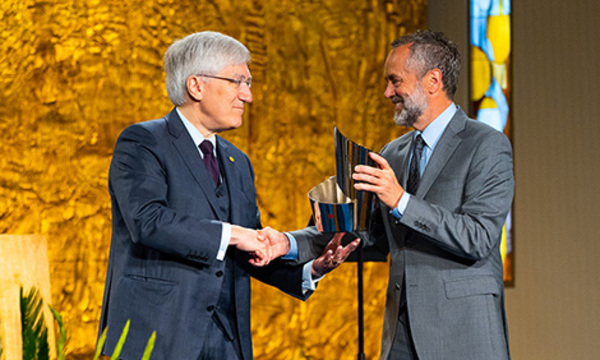
These days, there are about as many versions and translations of the Bible as there are flavors of ice cream at the supermarket. Whoever you are and whatever your preference, thereтАЩs a Bible for you.
In recent years there has been a spate of novelty Bibles directed toward increasingly specific niches тАФ Bibles for tweens, retirees, Demo crats, artists, athletes, apologists and so on тАж Gone are the days of simple leather-bound or zippered Bibles, where the flashiest component might be your gold-embossed name on the cover. Today, Bibles are looking more and more like magazines.
Recently, Biola Magazine sat down with Benjamin Shin, associate professor of Bible exposition at , to talk about the pros and cons of these novelty Bibles. We asked Shin about three Bibles in particular, all released in 2008: (Harper One), (Illuminated World) and (Thomas Nelson).

The Green Bible
Ben, what were your thoughts as you looked through The Green Bible?
Well, I thought it was an interesting concept. The fact that the Bible itself is made out of material that is environmentally friendly shows that the content and the way that it is presented match. I thought it was a unique approach to highlight in green all the тАЬearth centeredтАЭ Scriptures, and the essays in the foreword by the various scholars like N.T. Wright and Desmond Tutu were interesting.
What do you think of the idea of having topical essays like these at the beginning of a Bible?
I think itтАЩs helpful and is an approach that many Bibles use. So, for example, the recent is super thick because there are so many sermon notes and essays and commentaries within it. These things serve the purpose of helping readers become well versed (no pun intended) in a particular area, so I think itтАЩs helpful.
Does turning the Bible into a topical or thematic proof text do it harm?
I certainly think that some of the proof texts can be stretches. In one of the essays at the beginning of The Green Bible, for example, one of the authors argues that in the Genesis account, she had seen that every aspect of the creation was equally valid and good. Well, from the text that is not the case. It says that man, on the sixth day, is very good. She obviously had an agenda in her essay and was using verses to support it. This can be dangerous.
Looking at the verses that are highlighted in green, it seems like it is anything that has to do with nature, animals, food, weather, trees or anything outdoors. Do you have a sense as to the criteria they are using to classify a verse as тАЬgreenтАЭ?
Well in one sense it is definitely exhaustive. Whether or not it is directly applicable is another question. But I think their intention is to be exhaustive as opposed to textually accurate. Their point is just to say that Christians should be concerned about the earth, and this is why: Look at the frequency of creation language throughout the Old and New Testaments.
One of the verses they put in green is Philippians 1:21: тАЬTo live is Christ and to die is gain.тАЭ How is this тАЬgreenтАЭ?
I think itтАЩs talking about the temporality or mortality of earth, and that itтАЩs OK тАФ that this is part of the natural cycle. But you have to read into that a little bit.
Do you think that is a sound reading?
No, because itтАЩs not the authorтАЩs intent. ThatтАЩs the problem with some of these topical Bibles. You have to read it with a grain of salt, because they have an agenda and are trying to use every verse that is even slightly or tangentially related to their topic in order to advance their agenda. With any Bible, you should consult with other translations or commentaries to make sure that the reading is sound and capturing the authorтАЩs intent.

The Bible Illuminated
This was initially published in Sweden, a highly secular country where annual Bible sales are usually around 60,000. The Bible Illuminated has already sold 30,000 copies since it was released in Sweden last year. Is it a worthy endeav or if it at least sparks new interest in the Bible?
Considering the source and the audience, yes, because Europe has been so dead lately. What jumped out at me was that this Bible didnтАЩt have a Western face to it. There are quite a few images of Africans and Asians and not a lot of Westerners, aside from familiar celebrities like Bono and Angelina Jolie. For the person who is more visual or artsy, it certainly appeals to them. ItтАЩs definitely a unique Bible.
What do you think of some of the images and the overall style of it?
Some of it is rather graphic тАФ like the images of apocalypse in Revelation and the man on fire. The cover also struck me as having a dark, evil feel to it. It reminded me of Brandon LeeтАЩs character in The Crow. And then the back cover feels like some sort of specter or grim reaper or something. Maybe itтАЩs a European thing.
Do you think it has to do with the desire to re-brand Christianity as edgy and hip?
Certainly, which is probably also the intent of The Green Bible. In mission and in translation thereтАЩsthis concept of form and function. Functionnever changes, but the form can. ItтАЩs like inmusic. We used to listen to hymns in church, butnow we have everything from rock to rap. Themessage has remained the same, but the formhas changed.
Does the form ever influence the content?
It can. I wasnтАЩt comfortable when I saw the Dalai Lama in this Bible, for example. I donтАЩt know what purpose that serves. But if the intent is pragmatic тАФ to get a wider audience to read this тАФ then it might be effective.

Revolve
This is just one in the Thomas Nelson тАЬBibleZineтАЭ series, which also includes magazine-style Bibles for teen guys, young kids, 20-something women, тАЬtodayтАЩs modern guysтАЭ and тАЬthe vibrant urban crowd,тАЭ among others. Do you think itтАЩs OK to sell the Bible according to such rigidly demarcated market niches?
ItтАЩs OK in that it will probably reach people who wouldnтАЩt necessarily pick up a Bible initially. It may be a little bit behind the times in that kids these days are more on the Internet and donтАЩt really read, but if they were to read something, theyтАЩd probably choose this over a traditional leather-bound. ItтАЩs written in the New Century Version translation, which is geared toward third-grade level reading, so itтАЩs fairly simple. But the look of it is interesting and appealing.
What do you think about all the sidebars and magazine-style advice columns throughout the book?
Well itтАЩs good in that it emphasizes certain themes that are relevant, but in some cases I think that the answers they give тАФ like in the тАЬBlabтАЭ sections тАФ are too opinion-based rather than biblically based. Sometimes the answers come across too strongly as well тАФ making it sound like Gospel truth when itтАЩs just some guyтАЩs opinion.
What about the notion that the Bible as magazine тАФ which is something that we typically just have lying around in bathrooms and on coffee tables тАФ diminishes the level of respect or reverence we have toward Scripture?
It makes me think of Muslims, who revere the Koran so much that they would never put it on the ground, for example. In some ways we as Protestant Christians donтАЩt revere the Scriptures in that way. But it all goes back to form. What about the Bible on the Internet? ThereтАЩs a lot of bad stuff on the Internet, so does it diminish the status of Scripture that it appears in such a form? Should we not have it on there for that reason? IтАЩd rather have a Bible that reaches an audience in a way that is appealing to them rather than not reaching them at all. Paul talks in 1 Corinthians 9:21тАУ23 about becoming all things to all people, in order to save some. So thereтАЩs this whole idea in missions that some times you have to reach out to them in their culture, without compromising the message.
So, at the end of the day, if these novelty Bibles reach new audiences that might not otherwise read the Bible, youтАЩd say they are a good thing?
I would say yes, because I think the translations that they chose were overall pretty good and got the gist of it. As I read the prefaces and the reviews, it was clear that these Bibles were trying to reach certain groups that normally wouldnтАЩt read the Bible. I would say I favorably endorse The Green Bible and Revolve, and my verdict is still out on the Bible Illuminated.
For people who are trying to evaluate the merits of a certain translation or a certain Bible, are there resources they should consult?
ThereтАЩs a really good, quick read by Leland Ryken called Bible Translation Differences that I would recommend. Also, Philip Comfort has a book called Essential Guide to Bible Versions that is much more thorough and complete, delving into specific scriptural passages that vary within translations, and itтАЩs fairly recent.
 ╜ё╚╒║┌┴╧
╜ё╚╒║┌┴╧
.jpg)

